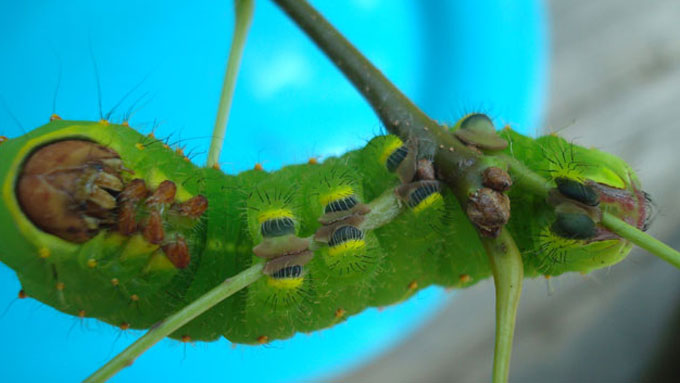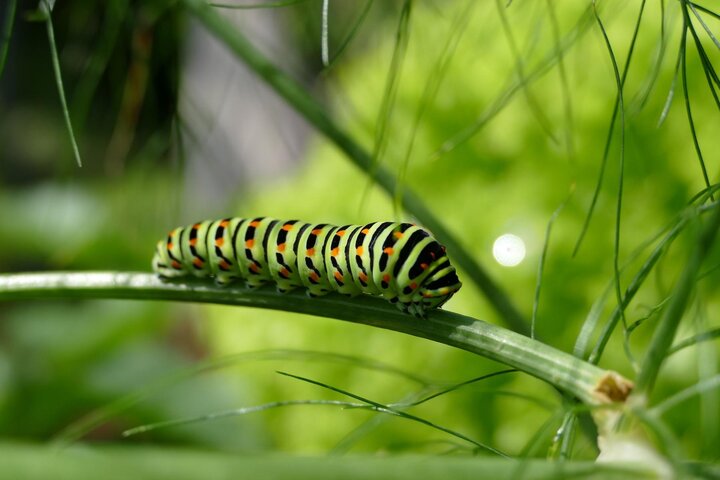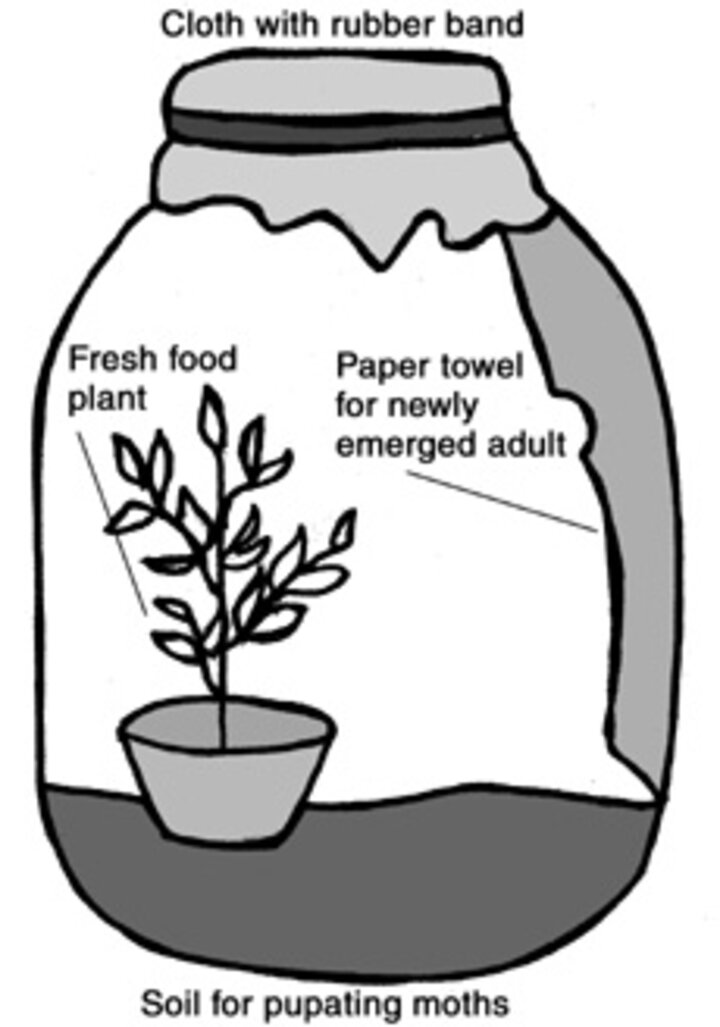This resource was written by Barb Ogg, PhD, Extension Educator Emeritus. It was updated August 2022 by Sarah Browning, Extension Educator.


Collecting Larvae
Butterflies and moth larvae are hard to find, but looking for known food plants can make the task easier. Different swallowtail caterpillars (like the one at the right) eat parsley, dill, carrot and parsnip greens. Look for monarch caterpillars on milkweed plants. Many large moth caterpillars like tomato and tobacco hornworms produce large amounts of frass (insect droppings). Carefully look above piles of frass for damaged leaves and the caterpillar. A list of plants where you may find butterfly larvae are listed below.
Before removing the larva from the plant, make sure you have access to plenty of fresh food plant for it to eat because the caterpillars may feed for several days to a week or more. If this is on someone else's property, be sure to ask before you pick leaves from plants. It may be against the law to remove insects/plants in state and national parks and preserves. Ask first.

Rearing Container
You will need an aquarium or large wide-mouthed jar with a lid. Perforate the lid or use a wide-mouthed jar ring with a screen.
Food
Nearly all butterflies and moth larvae eat plants. Since they are often very selective about what they will eat, it is important to note the plant on which they are found and keep fresh plant material available at all times. Depending on their size, the larvae will eat one or more leaves of their food plant every day. The larger the larva, the more it will eat so make sure that you have access to plenty of their food plant. Cuttings can be stored in a plastic bag misted with water in the refrigerator.
Because larvae obtain all of the water they need from their food plant, it is important to keep cuttings from the food plant fresh by placing the cut ends in narrow mouthed bottles of water. Always recut ends and quickly insert into water when transferring to a new container of water. When replacing old food plant, gently remove leaves or stems that the larvae are not sitting on and replace with fresh (unwilted) material. If the larvae are not eating, you either have identified the wrong food plant or the plant is too wilted and undesirable.
When the adult emerges from the pupa, a humid environment is required to allow the wings to expand normally. Keep a damp sponge in the cage when adult emergence is expected to provide sufficient humidity. If the container's lid is screened, place a piece of plastic over it to increase humidity. Make sure that mold does not become established in this environment.
Cleaning Up After Your Larvae
Lepidopteran larvae are eating machines and consequently pooping machines. Frass (i.e., insect droppings) needs to be removed to discourage mold. Gently remove water container and dump out frass. Every time you change the food plant, rinse out container and dry. Also change the water in the container for the food plant.
People often find caterpillars when the fully grown larvae are searching for a place to pupate (called the wandering stage). If you do not know what kind of lepidopteran you have, you should provide each of the following in your rearing container.
- Place and secure several sticks that lean against the side of the container to help the larva spin a cocoon.
- Place moist paper toweling or several inches of moist sand or soil for species which pupate in the soil (usually moths)
If you find a chrysalis hanging from a leaf or stem, you will need to somehow hang it from the top of the rearing container. You can break off the twig that the chrysalis is attached to and then tape or wire it onto the lid or shoulder of the jar. Sometimes you can just lean the twig against the inside of the jar, but make sure that there is enough room for the butterfly to hang upside down from the chrysalis and spread its wings. Breaking a chrysalis off the twig will probably kill the butterfly inside it.
Handling Larvae
Larvae of most lepidoptera are harmless. Some larvae react to being touched by rearing up one end of the body, and some may expose odoriferous glands, which are harmless to humans. Both actions are intended to repel predators. Newly hatched larvae can be transferred with a small paint brush. Adults have delicate wings that can be damaged by handling.
Some larvae have branched spines that can sting. Hairy larvae such as the woolly bears, which have abundant straight hairs, are harmless. Single spines are not a problem. Do not handle the container or disturb the larvae when they are molting. They are very susceptible to damage during this vulnerable transition. The same applies to the larva when it is becoming a pupa. Make sure that the holes in the water container are not too big. Lepidoptera larvae are not particularly wary and young larvae may wander down the stem and drown.
Sometimes caterpillars will be parasitized before you collect them. They may feed and pupate in your rearing container, but, the parasite usually flies or wasps will emerge instead of a butterfly or moth. Parasitism is very common in nature and shows how important biological control is in controlling insect populations. To make sure that you will end up with a butterfly or moth, you may want to collect and rear several larvae.
Some common butterfly larval host plants:
- Alfalfa - Medicago sativa
- Aster - Aster spp.
- Birch - Betula spp.
- Broccoli - Brassica spp.
- Butterfly Weed - Asclepias tuberosa
- Cabbage - Brassica spp.
- Cherry - Prunus spp.
- Chokecherry - Prunus virginiana
- Clover - Melilotus spp., Trifolium spp.
- Common Sunflower - Helianthus annuus
- Cottonwood - Populus deltoides
- Dill - Anethum graveolens
- Elm - Ulmus spp.
- Fetid Marigold - Dyssodia papposa
- Hackberry - Celtis occidentalis
- Hollyhock - Alcea rosea
- Lamb's Quarter - Chenopodum album
- Mallow - Malva spp.
- Milk-vetch - Astragalus spp.
- Milkweed - Asclepias spp.
- Oak - Quercus spp.
- Parsley - Petroselinum crispum
- Partridge Pea - Cassia fasciculata
- Prairie Clover - Dalea spp.
- Queen Anne's Lace - Daucus carota
- Red Cedar - Juniperus virginiana
- Snapdragon - Antirrhinum majus
- Sweet Fennel - Foeniculum vulgare
- Thistle - Cirsium spp.
- Wild Plum - Prunus americana
- Willow - Salix spp.